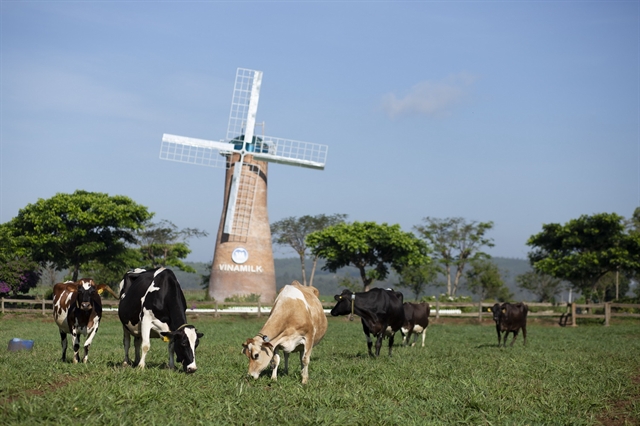Green growth is now a necessity, and private businesses are driving it with energy, creativity, and adaptability.

By Mai Hương
The private economic sector in Việt Nam must take a leading role if the nation is to succeed in its ambitions to hit net-zero emissions by mid-century.
The World Bank’s report 'Việt Nam 2045: Growing Greener', released last month, says that Việt Nam needs urgent changes to meet its climate goals.
Việt Nam emits less than 1 per cent of global greenhouse gas emissions (GHGs), but its carbon intensity is high due to coal use and energy-heavy industries.
Emissions have grown fast – 6.2 per cent yearly – mainly from power, industry and transport. Notably, exports account for 36 per cent of total emissions, putting increasing pressure on Việt Nam to reduce its carbon footprint while maintaining affordable energy and industrial competitiveness.
This rising trend poses growing risks to the country’s exportation.
In 2024, over half of Việt Nam’s exports – worth US$225 billion – go to OECD markets. With over 90 per cent of global GDP now committed to net-zero targets, green standards are becoming essential to enter these markets.
New trade rules such as the European Union’s Carbon Border Adjustment Mechanism will tax high-emission products. The mechanism starts with five product types and will likely expand.
At the same time, large global firms like Apple, Nestlé and Unilever require suppliers to measure and reduce emissions. This forces Vietnamese exporters to adapt or risk losing access to key markets.
According to Vũ Kim Hạnh, chairwoman of the Business Association of High-Quality Vietnamese Products, human and environmental health are now central to global consumer trends.
Based on her recent visit to ThaiFex in Thailand, she highlighted that eight out of the top 10 food and beverage trends this year are health-focused – such as the shift from animal to plant-based proteins and eco-friendly products.
However, Vietnamese businesses, especially small and medium-sized ones, are facing harsh challenges. Global economic instability, trade tensions, shifting tariffs and stricter regulations from major export markets such as the EU and US are making it increasingly difficult for them to compete.
Despite challenges, many Vietnamese businesses are taking action. Green economic activities have expanded rapidly. In 2020, these activities generated $6.7 billion, about 2 per cent of GDP, with growth of 10 to 13 per cent per year during 2018-20.
Private investment has helped renewable energy expand fast. Solar power has grown from nearly zero to 17 GW, driven mainly by the private sector. Việt Nam has strong wind and solar power potential of up to 1,000 GW each year. This makes the country a key location for clean energy in Southeast Asia.
In manufacturing, Việt Nam is also advancing, exporting components for solar panels, wind turbines and electric vehicles. In 2023, the country made up 5 per cent of the world’s solar panel exports. However, these gains face pressure. For example, US investigations into subsidies show the difficulties Vietnamese exporters must deal with.
Private companies also need to cut emissions in industries like steel and cement. This means using less energy, switching to cleaner fuels and trying new methods like carbon capture.
According to experts, businesses should create long-term plans that match their industry and finances. Training is important in areas like emissions reporting and environmental management. To succeed in markets like the EU or US, companies should use global standards such as the GHG Protocol and the Global Reporting Initiative.
Private businesses are showing strong energy, creativity and flexibility in this journey. Many large companies in Việt Nam are saving energy, cutting emissions, investing in renewables and reusing wastewater, showing a shift in mindset.
More private businesses are taking real action. In construction, firms like Phúc Khang, Ecopark, and Nam Long are building green urban projects certified by EDGE or Lotus. In agriculture, cooperatives and agri-businesses are using biotech, cutting chemicals and growing crops more sustainably.
Circular economy models are also spreading – from small recycling workshops and compost makers to big firms. For example, Vinamilk reuses treated water on pastures, and Unilever recycles used packaging through partnerships.

The green economy is already creating jobs. Today, it employs about 1.7 million people in Việt Nam. This number is expected to grow, especially in areas such as clean energy, smart agriculture, climate-resilient infrastructure and marine industries.
The Government has also started building the foundation for a greener, more resilient future. Resolution 68, issued in May by the Việt Nam Communist Party, marks a turning point for the country's private sector by positioning it as a key driver of the economy, with a strong emphasis on promoting green finance.
The resolution offers major opportunities for private enterprises to shift from a resource- and labour-intensive growth model to one based on science, technology, and innovation. Notably, it includes dedicated provisions to support green credit, particularly for smaller businesses.
To stay competitive and resilient to climate change, Việt Nam must both reduce emissions and keep costs reasonable for energy and production. Achieving this balance will need joint action from the Government, businesses and society.
The private sector is key to Việt Nam’s economy, making up more than half of GDP and employing 82 per cent of the workforce. As the country moves to a green, tech-based economy, this sector needs strong support to lead the way. VNS





